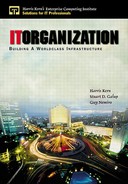Chapter 1. Introduction
We've traveled the world during the past few years, assessing infrastructures for Information Technology (IT) organizations for Fortune 1000 companies and new upstarts that have become the major portals to the Internet with market caps worth billions. We found that all of the organizations studied were facing the pressures of global competition and were trying to accomplish more with fewer resources. We met with executives, managers, and technical staff in a variety of industries on five continents. They knew that their computing environments would not stand the test of time. They were searching for information technology solutions to help them achieve competitive advantage. We were hired to help them get ready for the next business millennium.
Most of the organizations implemented their infrastructures over ten years ago, in some cases they actually started 30 years ago. We found large installed bases of legacy and client/server application software. In many cases, these organizations had architectures that resembled a collage of software languages, data storage (e.g., flat files, RDBMS, etc.), hardware, networks, and you name it. In some cases it was downright scary what we found.
Yet, you might ask what's so wrong with something that has worked for over ten years. Ironically, in many cases there really wasn't anything wrong with the infrastructure from a technical point of view. It worked! It may have been messy, but it worked.
The fascinating common thread we found in these organizations was that they were asking for help to solve technical issues and we found non-technical problems. The majority of the organizations were doing a fair job with the technology. Their problems centered on people and process issues. Even the new Internet and electronic-commerce-based companies have the same problems in spite of the fact that they are brand new companies with brand new technologies.
The process for gathering the data to write this book is a story in itself. While the individual case-study stories would make for entertaining reading, it's the lessons that we highlight from our research that are important. In a way, this is like therapy for IT organizations. The good thing about dealing with organizations is that we can diagnose what doesn't work and prescribe what can. So, let's start at the beginning. There's really only one way to gather infrastructure-related data and that's to perform an audit or assessment of the computing environment.
The challenge for us when we visit an organization is to do our assessment in less than five days. Most big consulting firms typically require a minimum of 30 days to provide this type of service for Fortune 500 IT infrastructures. And, these surveys are usually accompanied by a hefty price. Don't get us wrong, there's nothing wrong with these 30-day assessments. The results are usually a lengthy, well-written, and very detailed document of over 100 pages, depicting the many infrastructure-related issues. Actually, these reports represent an overwhelming and disheartening list of issues.
The first time the CIO sees the document, he or she is very pleased at the level of detail and is full of enthusiasm to get started to resolve the numerous problems. A special staff meeting is called to order. In attendance are his or her direct reports. The main agenda item is discussed with action items assigned. From this point forward, things have a way of deteriorating or just collapsing for many reasons:
Lack of funding to implement the recommendations.
Lack of time and resources to take on the numerous problems.
Executive management leaves the company. The new regime wants to do things their way.
Business issues/requirements take precedence.
No established metrics to determine how the recommendations are to be implemented.
The issues documented in the report are usually not much of a shock to the team of managers.
Our approach had to be radically different. When we do an assessment our goal is to provide a written analysis based on an evaluation of less than five days that:
Keeps things simple by focusing on one of our key methodologies (as discussed in Chapter 7)—minimum yet sufficient.
Provides no more than six recommendations that would have a significant impact on resolving the most critical issues and provide RAS to the infrastructure.
Provides a list of key methodologies. These methodologies become part of the overall vision when designing and implementing a worldclass infrastructure.
Highlights the issues in three categories: People, Process, and Technology.
Is based on separate 30-minute interviews with 15 to 25 IT staff and management personnel. Additional interviews are conducted with two of IT's customers.
Results in a written report of about 30 pages depending on the size of the company.
It's difficult for executives to believe that we can provide the information necessary to build a worldclass infrastructure in just a few days. After all, consulting firms have been doing infrastructure assessments for a quarter century. The duration has almost always been 30 days.
It's doable in much less time and we proved it. If you've ever read any of our previous books, Rightsizing the New Enterprise, Managing the New Enterprise, Networking the New Enterprise, and Building the New Enterprise, you know we focus on streamlining and reengineering just about every aspect of the infrastructure. Every aspect of the IT infrastructure these days needs to be continuously scrutinized to see if it's a candidate for reengineering, and that includes the way we assess infrastructures.
